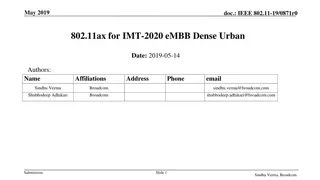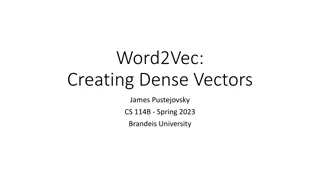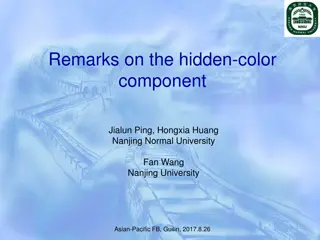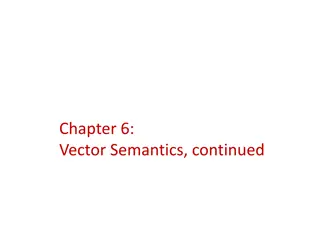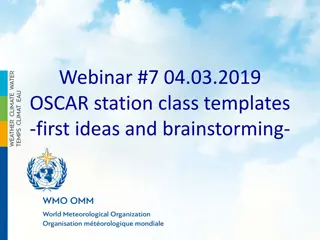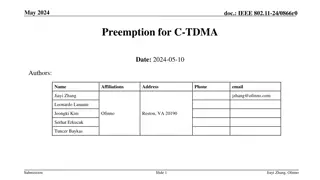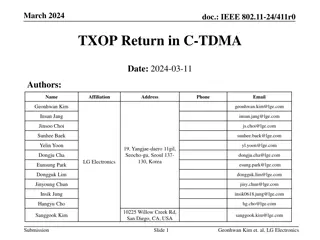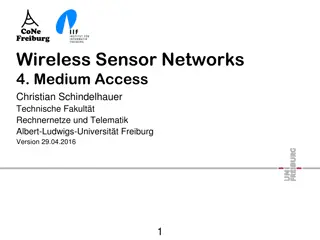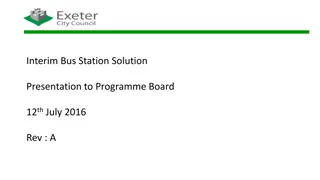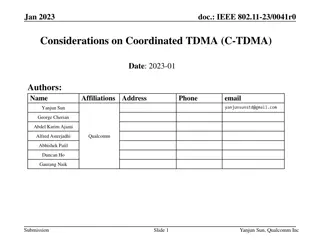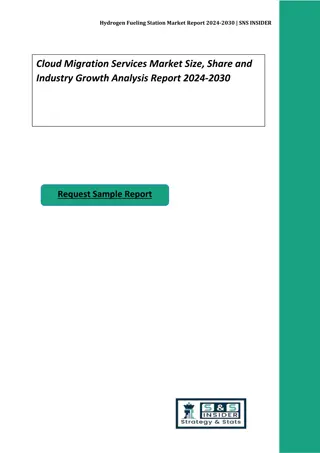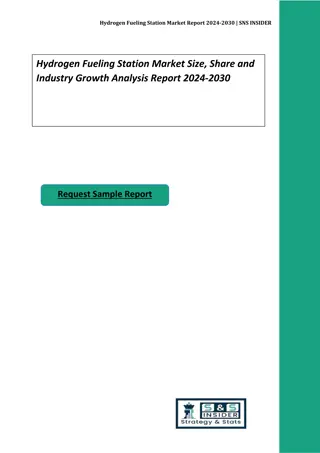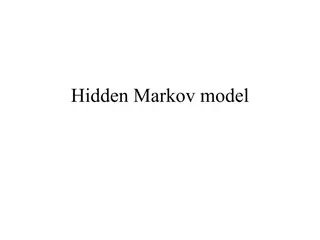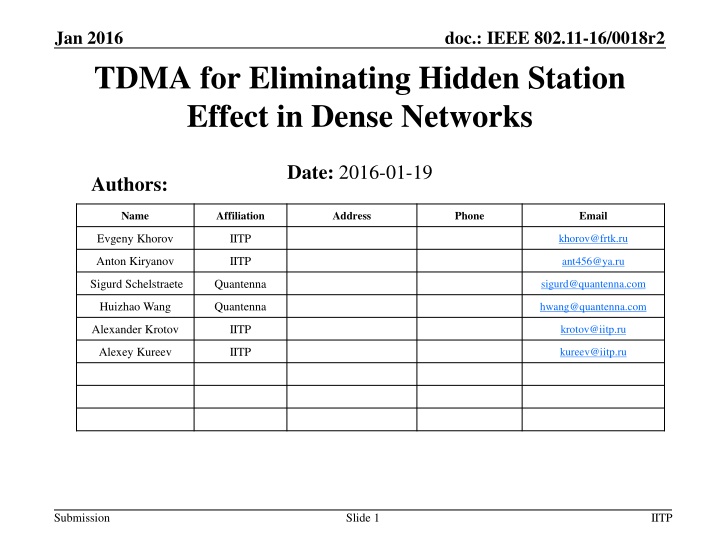
IEEE 802.11-16/0018r2: TDMA for Eliminating Hidden Station Effect in Dense Networks
Explore the research presented in the Jan. 2016 IEEE document focusing on TDMA to address the Hidden Station Effect in dense networks. The document discusses issues related to hidden stations, RTS/CTS efficiency, simulation in ns-3, and simulation results in varying network scenarios. Authors delve into physical and MAC layer parameters, simulation setups, and practical implications of network interference and throughput distribution.
Download Presentation

Please find below an Image/Link to download the presentation.
The content on the website is provided AS IS for your information and personal use only. It may not be sold, licensed, or shared on other websites without obtaining consent from the author. If you encounter any issues during the download, it is possible that the publisher has removed the file from their server.
You are allowed to download the files provided on this website for personal or commercial use, subject to the condition that they are used lawfully. All files are the property of their respective owners.
The content on the website is provided AS IS for your information and personal use only. It may not be sold, licensed, or shared on other websites without obtaining consent from the author.
E N D
Presentation Transcript
Jan 2016 doc.: IEEE 802.11-16/0018r2 TDMA for Eliminating Hidden Station Effect in Dense Networks Date: 2016-01-19 Authors: Name Affiliation Address Phone Email Evgeny Khorov IITP khorov@frtk.ru Anton Kiryanov IITP ant456@ya.ru Sigurd Schelstraete Quantenna sigurd@quantenna.com Huizhao Wang Quantenna hwang@quantenna.com Alexander Krotov IITP krotov@iitp.ru Alexey Kureev IITP kureev@iitp.ru Submission Slide 1 IITP
Jan 2016 doc.: IEEE 802.11-16/0018r2 Hidden STA Problem AP1 Frame BSS1 STA1 Collision AP2 Frame BSS2 STA2 AP1 and AP2 do not hear each other Transmissions of AP1 and AP2 can overlap, which results in a collision at STA1 Submission Slide 2 IITP
Jan 2016 doc.: IEEE 802.11-16/0018r2 Is RTS/CTS Really Efficient? AP1 RTS Data BSS1 ACK CTS STA1 Distance d NAV AP2 RTS BSS2 STA2 The distance between AP1 and STA1, and between AP2 and STA2 is fixed and equals 10 m. We vary distance d between AP1 and AP2 and measure throughput. We consider two cases With RTS/CTS Without RTS/CTS Submission Slide 3 IITP
Jan 2016 doc.: IEEE 802.11-16/0018r2 Simulation in ns-3 (1/2) Physical Layer Parameters Value (Ch 36, 5180) [80MHz] No shadowing IEEE 802.11ac VHT STA TX Power 15 dBm AP TX Power 20 dBm AP number of antennas 1 STA number of antennas 1 AP antenna gain 0 dBi STA antenna gain -2 dBi Guard interval 400ns (short guard interval) CCA threshold -76 dBm @ 80MHz Link Adaptation Fixed MCS = 5 (234.0 Mbps) Pathloss Model parameters d0 = 1, d1=10, d2=30, e0=2, e1=3.5, e2=3.5 Parameter Band Width Shadow fading Data preamble Submission Slide 4 IITP
Jan 2016 doc.: IEEE 802.11-16/0018r2 Simulation in ns-3 (2/2) MAC Layer Parameters Value [EDCA, AC_BE with default parameters] [CWmin = 15, CWmax = 1023, AIFSn=3 ] 1538 Bytes (1472 Data + 28 IP header + 8 bytes LLC + 30 MAC header) On, 32 MPDU aggregated Max number of retries 10 Beacons Disabled Throughput Per non-AP station (received bits/sim time) Parameter Access protocol MPDU size BlockACK Simulation Parameters Value 35 seconds Distance (AP#-STA#) Parameter Simulation time 10 m Submission Slide 5 IITP
Jan 2016 doc.: IEEE 802.11-16/0018r2 Simulation Results Fair area All devices are in range of each other. Throughput at any link is ~ 50% Little difference, if any, is caused by starvation during simultaneous transmission Unfair area For example, AP1 decodes ACK sent by STA2 incorrectly and waits EIFS instead of DIFS. AP1 has rarer channel access than AP2 Blocking area AP1 and AP2 do not sense transmissions of each other. All or almost all transmission attempts by AP1 are unsuccessful Low interference area For example, the transmissions in BSS1 and BSS2 cannot damage each other, however, the devices may encounter PHY-RXEND indicating errors or Rx frames with CRC errors, causing them to trigger EIFS, much longer delay than DIFS. No interference area BSS1 and BSS2 are out of the range of each other. Throughput at any link is 100% Submission Slide 6 IITP
Jan 2016 doc.: IEEE 802.11-16/0018r2 Blocking Area with Non-saturated Traffic Load at both links follows Poisson distribution with the mean value pkt/s. The problem exists even when the load is low, i.e. the unfairness appears when the load at both links is ~50Mbps. When the load increases, the first link experiences hidden station effect, while the second one gets as much channel time as needed. Submission Slide 7 IITP
doc.: IEEE 802.11-16/0018r2 Coordinated Channel Access Background Centralized PCF (IEEE 802.11) PCF Contention-Free Period Contention Period Beacon DCF DTIM NAV HCCA (IEEE 802.11e) Similar to PCF but more flexible. Applicable only for streams with known QoS requirements. No coordination between BSS SP (IEEE 802.11ad) Similar to PCF, but the PCP/AP allocates a periodic series of channel times for direct communication between pairs of STAs RAW/PRAW (IEEE 802.11ah) Similar to PCF, but channel times are allocated for a group of STAs Setup Request Setup Response DTIM Interval Distributed MCCAOP MCCAOP MCCA (IEEE 802.11s) Period DTIM Offset Duration HCCA TXOP Negotiation (IEEE 802.11aa) Similar to MCCA, but negotiation occurs between APs. During the reserved time intervals the AP accesses the channel with HCCA. No signaling protocol for APs that do not hear each other. No protection IITP Submission Slide 8
Jan 2016 doc.: IEEE 802.11-16/0018r2 Channel Time Reservation for OBSSs (TDMA) To decrease interference with OBSSs, an AP can reserve channel time for its own BSS Similar to MCCA, periodic time intervals are described by offset, duration, period, and TBD (e.g. number) Information about reserved channel time can be signaled in beacons or other frames Starting a transmission in alien intervals is prohibited (the exact behavior is TBD) In contrast to HCCA, channel reservation is not assigned to a stream In contrast to MCCA, the reservation can belong to a STA, a group of STAs or the whole BSS Reserved time intervals Beacon Beacon AP1 Offset Period Duration Submission Slide 9 IITP
Jan 2016 doc.: IEEE 802.11-16/0018r2 Simulation Results From Blocking Area BSS1 slot BSS2 slot BSS1 slot BSS2 slot BSS1 slot BSS2 slot BSS1 slot BSS2 slot 20 ms 40 ms 20 ms 20 ms 20 ms 20 ms 20 ms 20 ms 20 ms for BSS1, for BSS2 for BSS1, for BSS2 ~75% Diff without RTS/CTS is caused by collisions at the intervals borders ~25% Submission Slide 10 IITP
Jan 2016 doc.: IEEE 802.11-16/0018r2 Simulation Results Legacy Proposed Diff without RTS/CTS is caused by collisions at the intervals borders Submission Slide 11 IITP
Jan 2016 doc.: IEEE 802.11-16/0018r2 How to Inform OBSS STAs about Reservations? OBSS AP2 receives information about reserved time intervals directly from AP1 s beacon and includes this information in its own beacons. 1. AP2 AP1 TX range TX range AP2 AP1 STA2b 2. OBSS STA2a receives information about reserved time intervals directly from alien AP1 s beacon, and relays this information to its AP2. AP2 includes this information in its own beacons. AP1 AP2 TX range TX range AP2 STA2b AP1 STA2a Since reservations are made for a BSS, the changes of reservations are rare, so the amount of transmitted information is low. Note: STA2a in cases 2 shall understand that AP2 is unaware of time intervals reserved by AP1 (see the next slide) Submission Slide 12 IITP
Jan 2016 doc.: IEEE 802.11-16/0018r2 How to Inform OBSS STAs? (cont d) AP2 AP1 TX range TX range AP2 STA2b AP1 STA2a If AP2 knows time intervals reserved by AP1, then AP2 includes this information in its own beacons. STA2a receives both AP1 s and AP2 s beacons. Having compared information from AP1 s and AP2 s beacons, STA2a understands that AP2 is unaware of time intervals reserved by AP1. STA2a sends a frame containing information about time intervals reserved by AP1. Submission Slide 13 IITP
Jan 2016 doc.: IEEE 802.11-16/0018r2 Extra Protection To enhance transmission protectection within the reserved time intervals, the AP may transmit special frame which prohibits frame exchange for its own BSS, alien BSS STAs, or a particular subset of STAs. This frame is transmitted before the beginning of the reserved time interval. The AP may use prioritized channel access to transmit this frame. Submission Slide 14 IITP
Jan 2016 doc.: IEEE 802.11-16/0018r2 Conclusion The hidden STA problem leads to packet collisions and throughput degradation. The problem is critical in case of OBSS, which is a case of .11ax. We have shown that RTS/CTS mechanism cannot always solve the hidden STA problem. In contrast, periodic reservations do solve this problem. Such a solution can improve performance of .11ax networks. Submission Slide 15 IITP
Jan 2016 doc.: IEEE 802.11-16/0018r2 Reference [1] Masahito Mori, IEEE 802.11-15-0652r1, Reference simulation model for Dynamic CCA/DSC calibration. [2] Chinghwa Yu, IEEE 802.11-15-0886r0, DSC calibration results. Submission Slide 16 IITP
Jan 2016 doc.: IEEE 802.11-16/0018r2 Straw Poll Do you agree to add the following text in SFD: x.y.z The spec shall include a mechanism that allows an HE AP to negotiate periodic time intervals for its BSS in advance. During these time intervals, an OBSS or a subset of STAs in the OBSS should not start their transmissions. Y N A Submission Slide 17 IITP





